Fix: Cloned SSD Won’t Boot
Some users have been reaching us with questions after their cloned SSD is failing to boot. This issue is typically reported to occur if the user has used Acronis True Image or Macrium Reflect to clone a traditional HDD in order to avoid losing any data during the migration process. But the problem is the system doesn’t recognize the cloned SSD as a viable booting option so the user has no way of completing the startup sequence. Some affected users are encountering an error message (it differs from manufacturer to manufacturer) while others report that they only see a black screen.
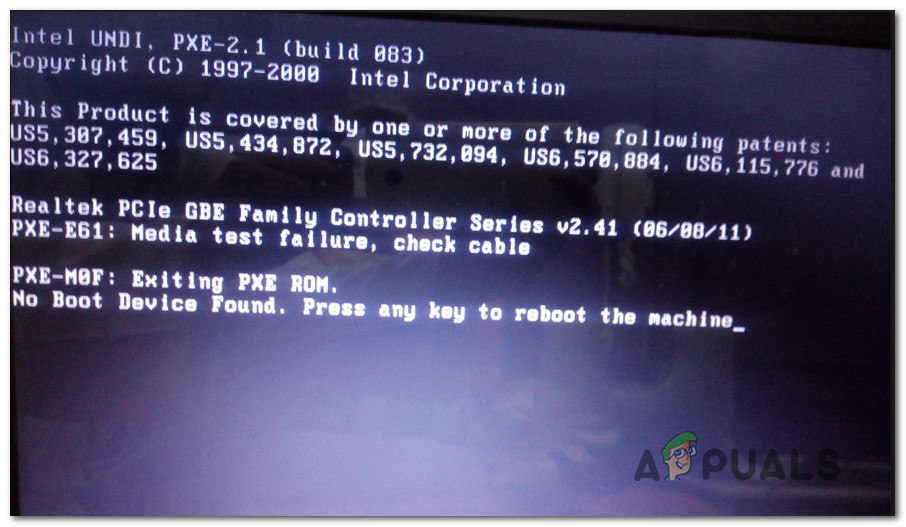
What is causing the cloned SSD to fail the booting sequence?
We investigated this particular issue by looking at various user reports and the repair strategies that most affected users have deployed to get the issue resolved. Based on our investigations, there are several different culprits that are known to trigger this particular error message:
- Source disk can’t boot – This typically happens in those scenarios where the source disk that was cloned had contained bad sectors. Naturally, those we’re migrated to the new drive and might have messed up the boot data. In this particular scenario, there is no repair strategy other than using a recovery tool to fetch the data from the old HDD and clean installing Windows on the SSD.
- The drive is not set to boot – During the process of cloning the source disk and connecting the SSD to the new computer, the drive will not preserve its boot priority. This means that you’ll need to access your BIOS/UEFI settings and instruct your computer to boot from the new SSD drive.
- Cloned SSD and source drive have the same unique ID – There are a lot of cloning software products (including Samsung Magician) that will mistakenly copy the unique ID during the cloning process. This ends up confusing the boot manager. In this case, removing/wiping the original drive will resolve the issue.
- Faulty SATA cable / SATA port – We have seen several reports in which the SSD drive was refusing to boot due to a problem with the SATA cable used for the connection. Several users have managed to resolve this particular issue by using a different SATA cable or SATA port.
- Secure boot is enabled – HDD cloning and Secure Boot will not play well on most PC configurations. Since the majority of free migration software will copy some uniques IDs over to the cloned SSD, the secure boot feature might prevent the system from booting from the new drive. In this case, disabling the Secure Boot feature from the BIOS settings should resolve the issue.
- GPT/MBR conflict – In cases where the user cloned a GPT HDD to MBR SSD (or MBR HDD to GPT HDD), it’s necessary to change the boot mode from UEFI to Legacy or from Legacy to UEFI. If the wrong boot mode is set, the cloned SSD will not boot up at all.
- Boot configuration data got corrupted during migration – Cloning an SSD will always be a bit of a gamble. Depending on the source disk and the SSD you’re trying to clone on, you might find that the BCD data gets corrupted during the migration process. In this case, using the WinRE utility or BootRec.exe utility should resolve the issue in most cases.
If you’re struggling to resolve this particular error message, this article will provide you with several troubleshooting guides that other users in a similar situation have successfully used to force the cloned SSD to boot normally.
Keep in mind that not every potential fix will be applicable to your current scenario. Because of this, we advise you to follow the methods below in the order that they are presented. One of them is bound to resolve the issue in your particular scenario.
Method 1: Setting the correct Drive to boot from
One of the most common reasons that will make a cloned SSD unbootable is the fact that the user has forgotten to set the correct drive to boot from. If this scenario is applicable, a trip to the BIOS / UEFI settings and changing the boot priority accordingly should resolve the issue immediately.
Here’s a quick guide on how to do this:
- Restart your computer.
- During the initial screen, start pressing the Setup key to enter the BIOS / UEFI settings. The specific setup key should be visible on the initial screen, but just in case you don’t manage to spot it, you can search online for the Setup key according to your motherboard manufacturer.

Press [key] to enter setup - Once you get inside the setup screen, look for the Boot tab and make sure that the cloned SSD has priority.
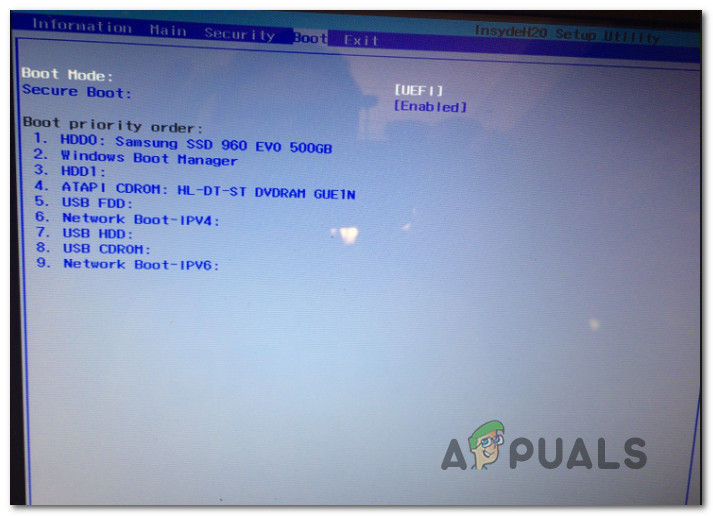
Setting the cloned SSD at the top of the list - Save the changes, exit the Setup screen and see if the issue is resolved at the next startup.
If you’re still unable to boot from your cloned SSD, move down to the next method below.
Method 2: Changing the SATA cable used to connect the cloned SSD (if applicable)
We have seen several confirmed reports where this particular issue was occurring due to a faulty SATA cable or a faulty SATA port. If you’re suspecting that the issue might be caused by a connection problem, it’s recommended to try changing the SATA cable and the SATA port (if applicable) and see if the issue is still occurring.
And since you’ll open the case, it’s also worth a shot to disconnect any non-essential from the power supply just to make sure that the power supply gives the SSD enough power.
Method 3: Remove / Wipe the previous drive
Several cloning utilities including Samsun’s Magician will also copy the drive’s uniques ID, which ends up confusing the system. Since it won’t know where to boot from, it will likely make only one of the drives usable.
Fortunately, you can resolve this particular issue by simply removing the source disk (the one that you cloned). If your system is able to boot from the cloned SSD, you’ll need to wipe the original drive in the event that you want to use both on the same PC configuration.
Method 4: Disabling Secure Boot
Secure boot is a security standard developed by members of the PC industry in order to ensure that the PC will only boot with the software trusted by Original Equipment Manufacturers (OEMs). As you might imagine, this can create problems with cloned SSDs since the migration software that you used might copy over some unique IDs which might be regarded as a security breach by the secure boot feature.
In this case, you have little choice but to disable secure boot. Here’s a quick guide on how to do this:
- Start your computer and press the Setup key during the initial screen. Your specific Setup key should be visible on the initial screen, but just in case it isn’t, search online for it according to your motherboard manufacturer.

Press [key] to enter setup - Once you get inside your BIOS/UEFI settings, go to the Security tab and set Secure Boot to Disabled.

Disabling Secure Boot Note: BIOS / UEFI menus are very different from one manufacturer to another. Under certain configurations, you will be able to disable Secure Boot from System Configuration, Authentication or the Boot tab.
Method 5: Changing the BIOS Boot mode
If you’ve cloned a GPT HHD to MBR SSD or an MBR HDD to GPT SSD, keep in mind that it’s necessary to also change the boot mode from UEFI to Legacy or vice versa in order for the boot sequence to be successful. Otherwise, the SSD drive will not boot after the cloning process is complete.
If this particular scenario is applicable, you can resolve the issue by changing the boot mode. Here’s a quick guide on how to do this:
- Power on your computer and press the specific boot key (Setup key) during the initial startup sequence. Typically, the setup key is either one of the F keys (F2, F4, F6, F8, F10, F12), the Del key (on Del computers) or the Esc key.
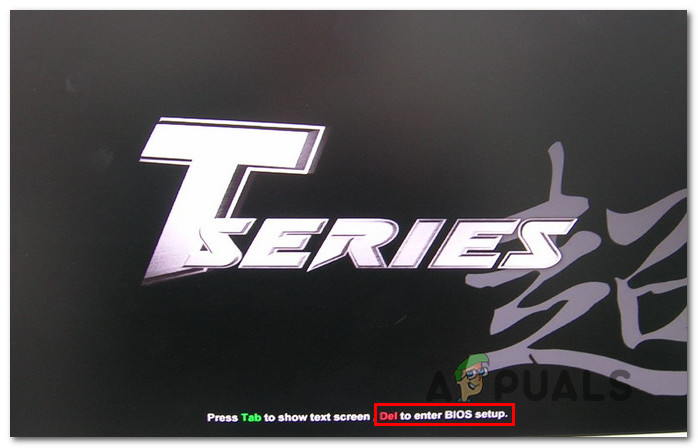
Pressing the Setup key to enter BIOS settings - Once you get inside your BIOS setup screen, go to the Boot tab and change the Boot Mode. If it’s set to Legacy, change it to UEFI and vice versa.
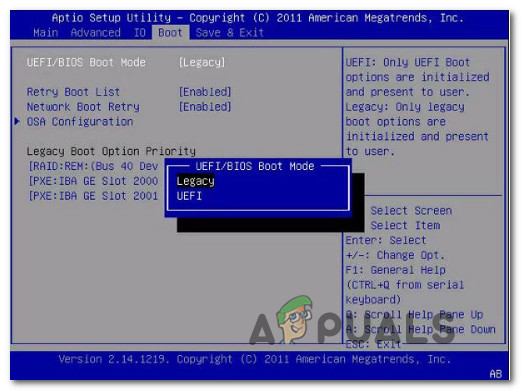
Changing the Boot Mode Note: Keep in mind that depending on your motherboard manufacturer, this menu might look very different on your screen.
- Save the current BIOS configuration and restart your computer to see if you are able to boot from the cloned SSD drive.
Method 6: Running the Windows Recovery Environment utility
The Windows Recovery Environment (WinRE) is capable of fixing a lot of common scenarios where the drive becomes unbootable. Several affected users have reported that they were allowed to boot normally after they repaired the Windows installation from the cloned SSD using WinRe.
But keep in mind that in order to perform this procedure, you’ll need to get a hold a Windows Installation media with your operating system version. You can follow this article (here) for Windows 7 or this one (here) for Windows 10 to create an installation media if you don’t have one.
Here’s a quick guide on how to run the Automatic Repair utility:
- Insert the installation media and restart your computer. During the beginning of the startup sequence, press any key to boot from the Windows installation media.

Press any key to boot from installation media - Once the Windows setup is loaded, click on Repair your computer (bottom-left corner of the screen.

Choosing Repair your computer from Windows Setup - Once you get to the next menu, go to Troubleshoot, then click on Advanced Options. Next, from the Advanced options menu, select Startup repair.

Launching the Startup Repair utility - Wait for the utility to launch, then click Continue to proceed to the diagnostics phase. If you have a password, you will be asked to provide it.

Providing the required credentials - Wait until the WinRE utility is finished scanning and repairing the boot problems related to your cloned drive.
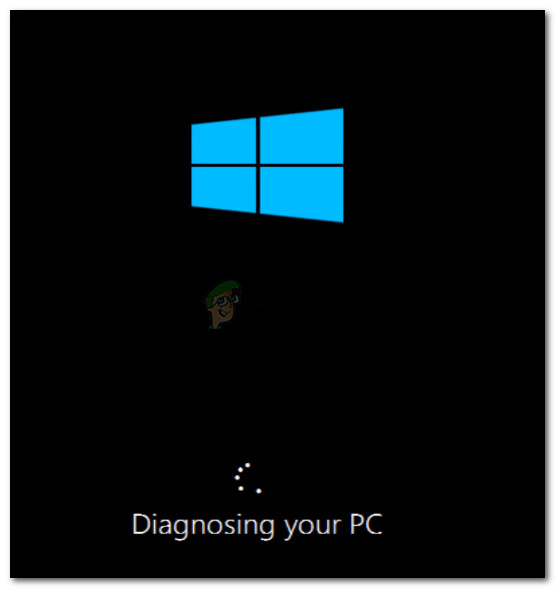
The Automatic Repair Utility is scanning the PC - Once the process is complete, your computer will restart. At the next startup, check to see if the issue is still occurring.
If you’re still unable to boot from your cloned SSD drive, move over to the next method below.
Method 7: Running the Bootrec.exe utility
If WinRE was unable to resolve the booting sequence of your cloned SSD drive, you might be able to do it manually by using Bootrec.exe via Command Prompt. This built-in Microsoft utility is capable of fixing the master boot record, the boot sector, and the boot configuration data. All of these three items can be affected during the migration process.
Note: Similar to Method 6, you’ll need to get a hold a Windows Installation media with your operating system version. You can follow this article (here) for Windows 7 or this one (here) for Windows 10 to create an installation media if you don’t have one. If you don’t have one, you can also force the Startup Recovery menu to appear by forcing three consecutive startup interruptions.
Here’s a quick guide on running the Bootrec.exe utility:
- Insert the Windows installation media and press any key when prompted to boot from it. Once you see the initial Windows installation window, click on Repair your computer.
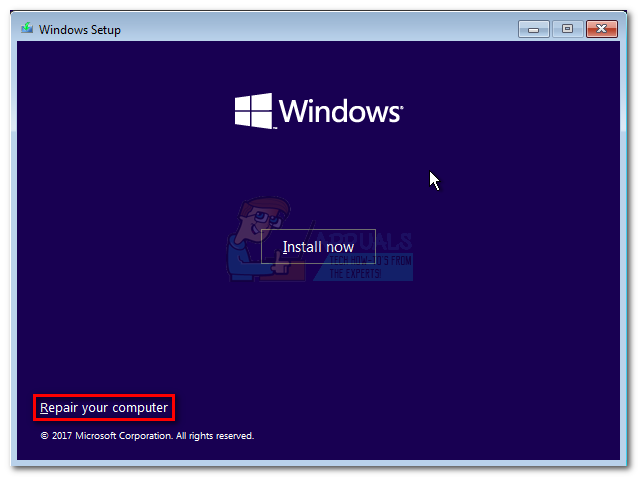
Accessing the Recovery menu via the Repair your computer button - Once you get to the Advanced Options menu, go to Troubleshoot then select Command Prompt.

Choosing Command Prompt in Advanced Options - Once Command Prompt is opened, type the following commands in the order that they are written and press Enter after each one to rebuild the entire build configuration data:
bootrec.exebootrec.exe /fixmbr bootrec.exe /fixboot bootrec.exe /scanos bootrec.exe /rebuildbcd
- Once all commands have been successfully inputted and processed, restart your computer and see if you are able to boot from you cloned SSD drive.





